Geophagus: varieties, recommendations for keeping and breeding
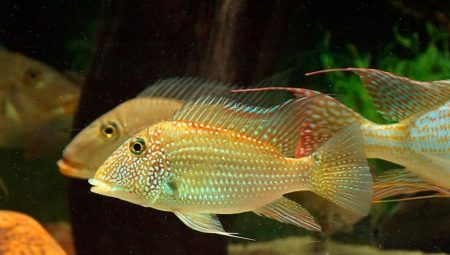
Geophagus are very beautiful fish that "sailed" to us from South America. Many people decide to acquire these amazing creatures. With them, the aquarium comes to life, is painted in bright colors. Let's take a closer look at these original aquarium inhabitants.
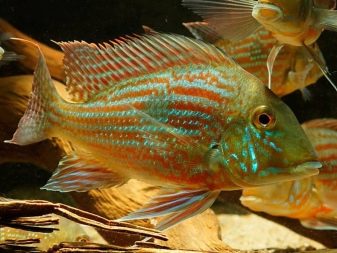
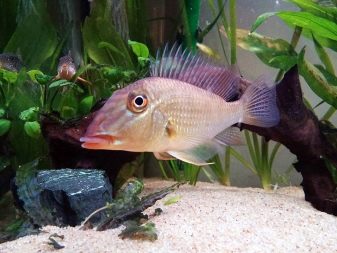
Description
The homeland of geophaguses is South America. There, fish live in local rivers. They are medium to large in size. The standard length of fish reaches 10-12 cm. Representatives of this species are more suitable for spacious areas of natural reservoirs. For this reason, it is not recommended to keep them in small aquariums. For geophaguses, large reservoirs are required, in which they will not be cramped.
Geophagus should be kept in aquariums, where there is not only fine-grained pebbles, but also specialized high-quality soil. The second name for geophaguses is earth-eaters. Such a nickname was given to them for the way of obtaining food - they constantly swarm in the ground, collect it in the oral cavity, and then extract from there everything that cannot be eaten. It is important to keep this feature in mind when setting up a safe and comfortable aquarium for them.
There are many interesting species of geophagus. It can be difficult not only for a beginner, but also for an experienced aquarist to find a specific fish.

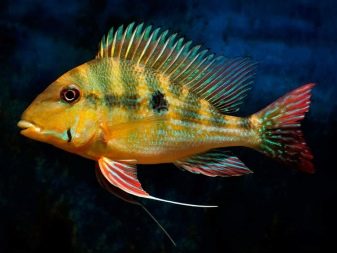
Species overview
There are many varieties of ground fish. Representatives of each subspecies have their own characteristics and external data. Let's consider them in detail.
Surinamese
The homeland of these fish is the northeast of South America. There, individuals live in slow-flowing or standing bodies of water. The typical body length of Surinamese fish is 15 to 20 cm.Males are golden orange in color. On their body there are many carmine and green-blue spots, stripes. The eyes are blue too. There is a round dark spot in the middle of their body. The tail is a lyre with elongated braids.
By themselves, the Surinamese geophaguses are peaceful, have a calm disposition. They hardly touch the vegetation, they practically do not dig the ground. But all of these behavioral features are characteristic of well-fed individuals. If such a geophagus is hungry, then in search of food it will tirelessly dig up the entire landscape.
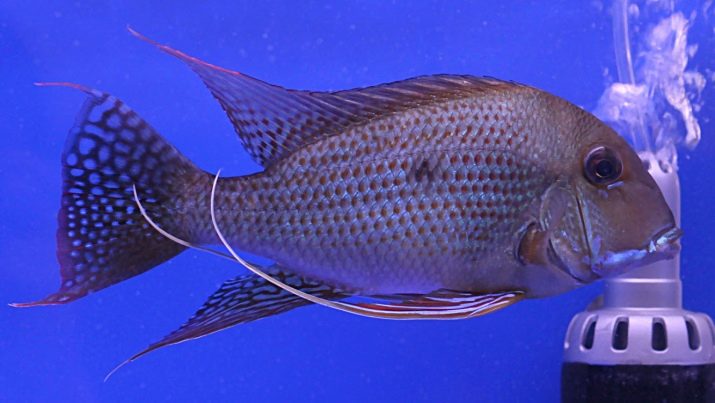
Brazilian
The name of this species speaks volumes. The homeland of fish is the east and southwest of Brazil. In the conditions of these territories, individuals prefer to be in reservoirs with a sandy bottom.
Representatives of the Brazilian species are very different from their other counterparts. Their body is less compressed at the sides and is more arched. The size of the eyes is smaller than that of other species. The mouth is located higher. These fish are large in size - they can grow up to 30 cm in length.
"Brazilians" have beautiful variations of body colors: emerald-turquoise, gray-yellow and even red-brown. Females and males of the species differ markedly from each other. Males always have more impressive size, long fins, and they have a special fat lump on their heads.

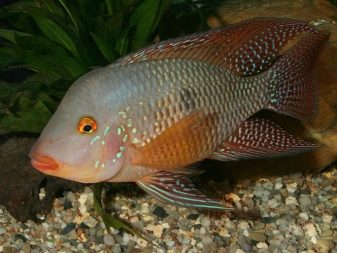
Geophagus Steindachner
In aquarium conditions, these fish can grow up to 15 cm. Their body has an interesting shape, similar to the red-headed geophagus, but the back is more arched than the abdomen. The body color of individuals of this species can be olive or gray-brown.
In case of excitement or during spawning periods, several dark vertical stripes appear on the body of Geophagus Steindachner. Scales in certain areas have a beautiful golden tint. The tail and fins have a scarlet edging.
These fish also have a red-brown fat bump.
In adults, it is located on the forehead.
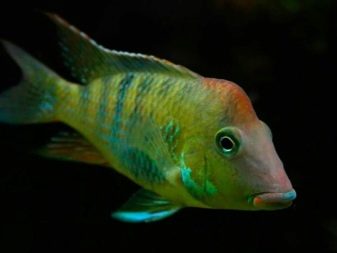
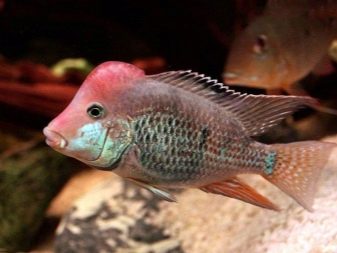
Redhead
Popular and widespread species. Its representatives are often found in pet stores. The red-headed geophagus has a tall, elongated body. It is slightly flattened on the sides. The standard adult length rarely exceeds 25 cm.
The body color of the fish is pale silver or golden olive. This parameter largely depends on the conditions in which the underwater pet is kept. Across the base color, pale stripes of a dark olive hue can be seen, and in the center there is a large and black spot that has an almost round shape. At the edges, the scales are distinguished by a delicate turquoise tint.
Sex can be determined only in those individuals who have reached 5-6 months of age. At this time, in males, the forehead and fins begin to turn red. Adult males are larger than females, at the same time, they are characterized by elongated rays on the fins and a bright body color.

Tapajos
Another type of geophagus with a red head. Fish of this species are distinguished by a beautiful color of the scales. They have a lot of similarities with red-headed individuals, but are brighter. They got their name in honor of the river where this species was first discovered.
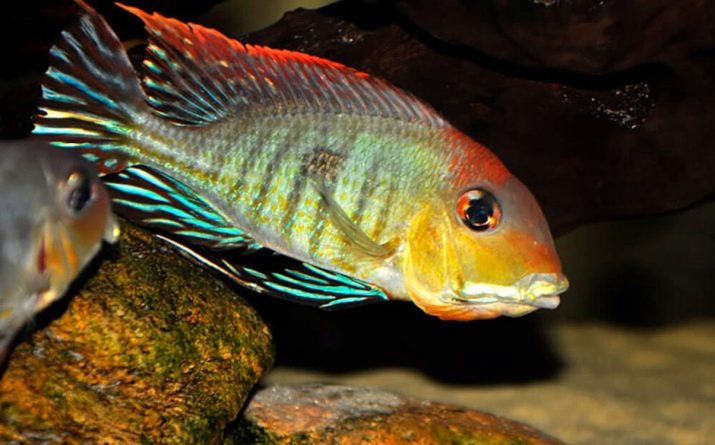
Hyporanga
These are beautiful medium-sized fish. Males can reach 9-10 cm in length, and females - 6-8 cm. Males have a distinctive feature - the occipital hump. The color of the body of individuals is red-brown, there are rare blue blotches. Their number is predominant on the tail and fins.
Geophagus Hyporanga is an omnivorous fish. They usually find food for themselves in the bottom layers. For 5-8 individuals, it is necessary to select an aquarium, the volume of which will be at least 100 liters.

Yurupari
This species is also called yurupara. Males grow up to 18 cm in length, and females are slightly smaller - up to 15 cm.Otherwise, there are no serious differences in individuals of different sexes. The body color of the fish is uniform. Depending on the lighting conditions, the color may appear beige or silver. On the large head there is an interesting decoration in the form of a beautiful ornament consisting of lines of a dark shade. A black dot can be observed at the base of the tail.
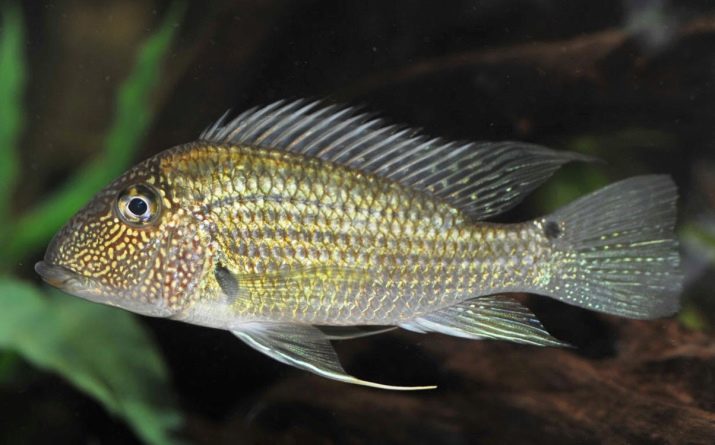
Proximus
Adult geophaguses of this species reach 20-22 cm. Males have larger body sizes than females. They are distinguished by their bright color, they are characterized by elongated rays of the fins. These fish have a beautiful bluish color, but it is not striking due to the characteristic yellow-orange pigmentation. There is a large dark spot on the body. The fins and tail are red.
For fish of this species, a large aquarium is needed - for 5-8 individuals, it should be at least 600 liters.
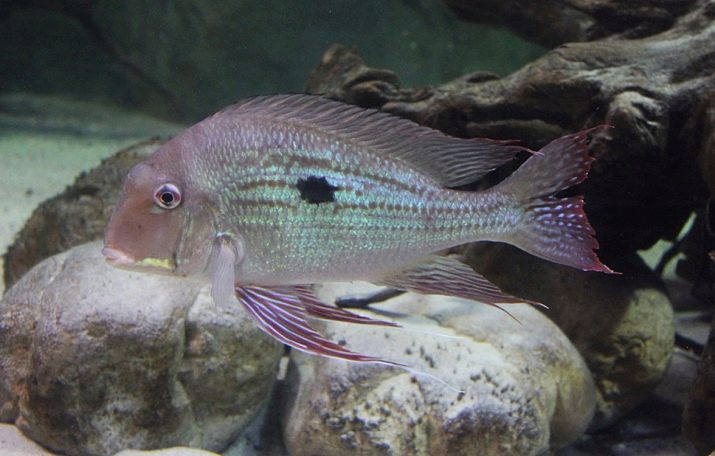
Balzani
Despite their large size and not the cutest appearance, these fish do not pose a real threat to other inhabitants of the aquarium. They are territorial only during the breeding season. It is recommended that you equip your aquarium so that it looks like a rainforest pool. All details and decorations must be fixed conscientiously, otherwise the earth-eaters will ruin everything.
Males of this species can grow up to 20 cm. Fish are peaceful and need a lot of shelter in aquarium conditions. It is desirable to keep 1 male and 2-3 females in one tank.

Altifrons
Beautiful, large fish. Their body length can range from 20 to 22 cm. Natural color can vary depending on the region of origin. There are fish, the color of which is presented in a rich range from reddish-orange to blue shades. Some experts explain this "spread" in colors by the presence of a large number of subspecies.
Determining the sex of an individual of this species is not very easy. There are no obvious and noticeable differences between females and males.
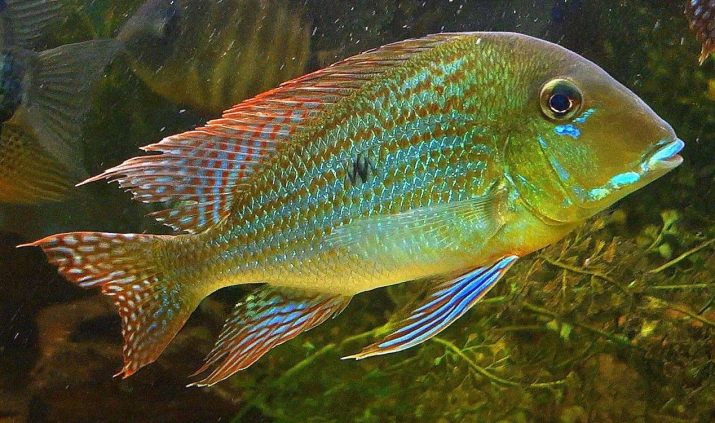
Weinmiller's Geophagus
Interesting fish originally from South America, from the territory of Venezuela. They live in reservoirs with clean, not muddy water. They prefer to keep along gentle banks.
Adults can have a body length of 18 to 20 cm. The natural color is yellow-orange. There are beautiful bluish stripes. The latter stretch from the tail to the very head. In the middle part of their body there is a well-visible dark speck. The fins are red, diluted with light blotches.
There are no noticeable differences between individuals of different sexes. Under natural conditions, these fish mainly feed at the very bottom, sifting through the sand, looking for small organisms. These individuals can only be kept in a sandy aquarium.
By their behavior they are calm, not conflicting. They are compatible with many representatives of other species, but they can accidentally eat neighbors that are too small (about 1 cm in size).
For 5-8 Weinmiller geophaguses, a large aquarium with a volume of at least 500 liters is needed.

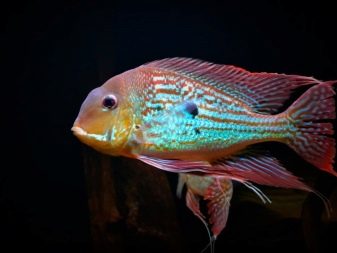
Sven
Relatively peaceful, calm, polygamous species of fish. True, males can sometimes behave cocky in relation to their own kind and other geophaguses. They cannot resist cichlazomas, even if they are more impressive in size. This fact is important to consider when choosing the species composition of the aquarium.
Sven males are always larger than females. Mature males have a noticeable bold growth on the head, a more saturated color. The sex of the fish can be determined as soon as they are 3-4 months old. The juveniles are distinguished by a grayish color, diluted with dark spots.
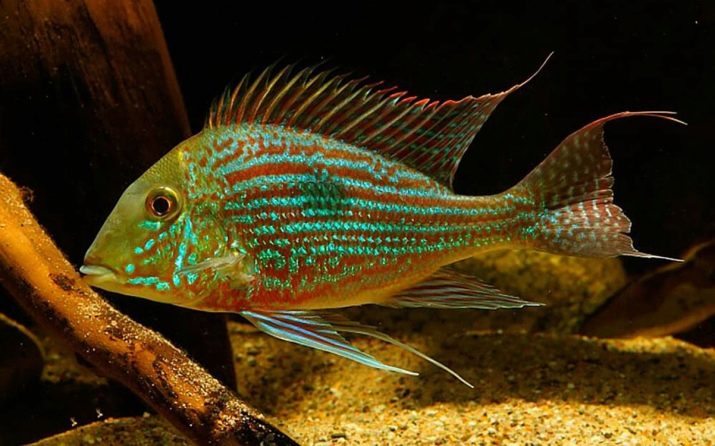
Orange-headed
This species comes from the central part of Brazil. Mature individuals can reach 20-25 cm in length. Males are larger than females and have characteristic rich colors. They have a slightly pointed fin on the back. Alpha males often have a hump on their heads. The body color is close to gray, with rows of pale red stripes and strokes on it. The head has an orange tint, and the fins are rich, combining blue and red colors.
These fish are calm, peaceful. They can live peacefully in the same aquarium with other species. Relationships within this type are built in accordance with a clear hierarchy. The alpha male is in charge. It is recommended to keep these fish in small groups of 5 to 8 individuals.
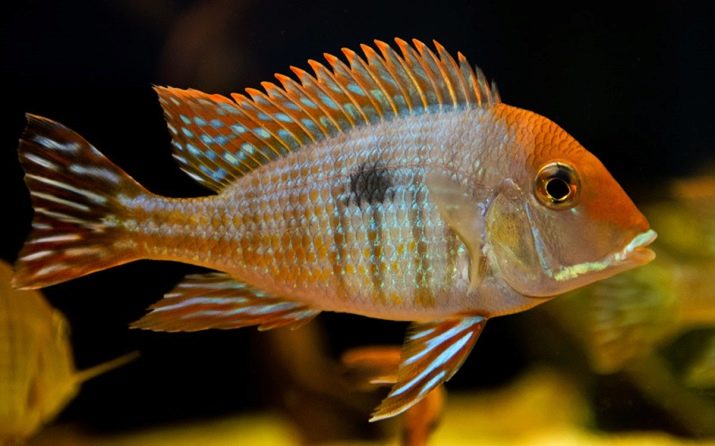
Features of the content
Aquarium geophagus need a large and spacious aquarium. The volume of the tank should not be less than 300 liters. This requirement is due to the fact that fish of this species grow to impressive sizes, and they require a lot of space.
These fish prefer to live in the lower layers of the water. They like weak, not too bright lighting in the tank, and when the light is not strong, they become slow, sedate. At the bottom of the container in which the fish live, sand of a coarse fraction should lie. Since the geophagus will definitely dig up the soil, you will need to equip the aquarium with a powerful, high-quality filter. In addition, you will need to securely and firmly fix absolutely all plants and decor items as much as possible so that the fish cannot dig them up and pluck them from their places.
It is important to monitor the condition of the water. The temperature should be between +16 and +30 degrees Celsius (optimal values are +20.25 degrees). The acidity should be 5-7, and the hardness 5-15 units. It is important to filter the liquid regularly.
A third of the water in the aquarium should be changed every week.
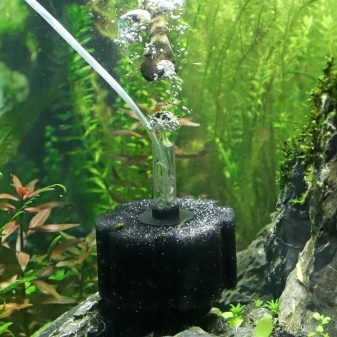
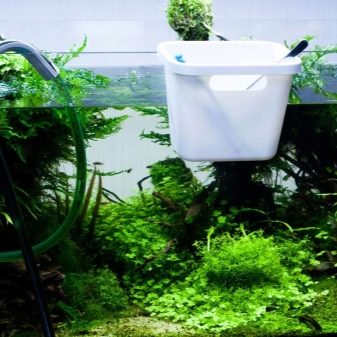
Geophagus need to be fed properly. Some people choose homemade food to feed their underwater pets. And it is also allowed to feed these aquarium fish:
- alive;
- frozen;
- dry, sinking food (brine shrimp, bloodworms and others).
Geophagus are not capricious in matters of nutrition. They are omnivores. They can be given minced shellfish, boiled pumpkin, lettuce leaves. It is recommended to give food in small portions. Vegetable components should prevail in food.
It is important to ensure that the food of these fish is as varied and rich as possible. Food should be complete, rich in vitamin complexes. If geophagus are not properly kept and fed poorly, they will experience severe growth retardation. Many diseases can occur that are difficult to control.
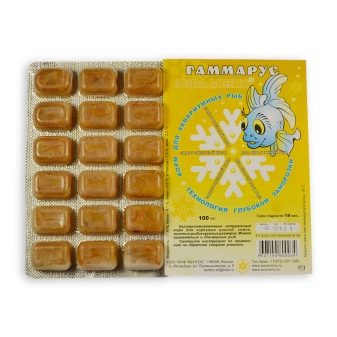
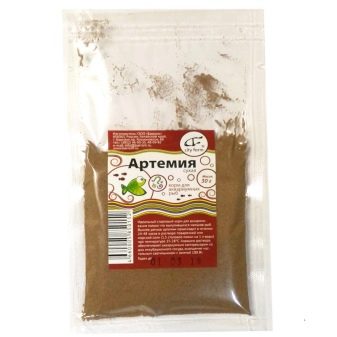
Compatibility with other fish
Before you start these beautiful and unpretentious fish, you should figure out what species they can normally coexist with. Geophaguses in rare cases demonstrate anger and aggression towards other individuals, but they can not get along without problems with all fish. Geophagus are especially dangerous during spawning periods. During this time, males can behave aggressively even towards other females.
There is a clear hierarchy in a school of geophagus, therefore it is recommended to keep them next to other fish in a spacious large aquarium. Ideal neighbors for these beauties are scalars, gourami and other cichlids.
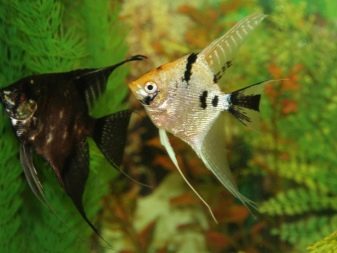
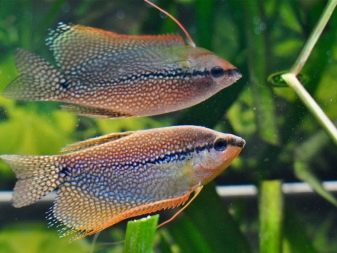
Breeding
If you plan to breed these fish, you should take into account all the features of the process of their reproduction - in representatives of the described species, it happens differently than in other fish. It is almost impossible to make a pair of mature individuals, since the male may not accept the female, start chasing her or even kill her. Ideally, the male should be younger and smaller in size. The water parameters do not have any effect on the reproduction of these fish, however, experienced breeders still advise adhering to the optimal indicators:
- the water temperature should be +16.23 degrees Celsius;
- dH up to 10;
- pH 6-7.2.
The usual spawning time is 0.5-1 hours.
The female lays eggs in an amount of about 200 or 1000 pieces. This is usually done on stones or some other clean surface in the tank. After 3-4 days, the first larvae will begin to hatch. The mother will immediately move them to a pre-prepared hole made in the sandy ground.The female can hide the offspring several times and do this until the fry begin to swim on their own.
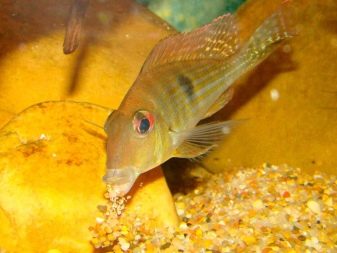
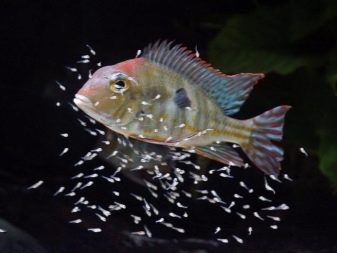
The withdrawal period lasts for about three months. It consists in accompanying a school of fry, lifting feed from the bottom, grinding large pieces of food. At first, this is done exclusively by the female, and a little later, the male is also involved in the process. Sometimes conflicts arise between parents and struggle for custody of young people. In rare cases, such events lead to the death of the female. In order not to face such serious problems, it is recommended to completely isolate juveniles from mature individuals. However, this will be possible only after the kids switch to self-feeding.
Young individuals look inconspicuous. They have subtle gray-green tones. At first, they should be fed:
- rotifers;
- nematodes;
- micromine.
After 6-9 months, babies can grow up to 10 cm in length and will be able to produce offspring themselves.
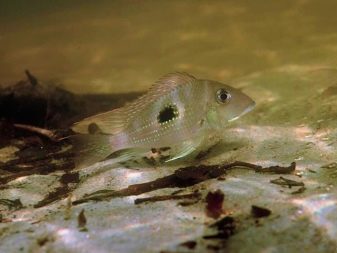
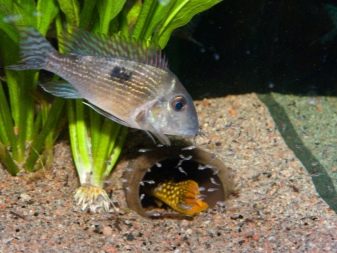
Useful Tips
Consider several useful tips for keeping geophagus.
- It should be noted that the Brazilian geophagus is the most aggressive species. He demonstrates aggression even in relation to representatives of his own species. This is important to consider when buying such fish.
- Geophagus have good immunity, but sometimes they can get sick. Most often, they suffer from the same diseases that cichlids are prone to. If you notice a "sore" that has appeared, the diseased fish should be isolated from healthy individuals as soon as possible.
- Fish must be chosen carefully. They must be active, mobile, absolutely healthy. If there is any suspicion of the state of the geophagus, then it is better to visit another pet store.
- These fish need a fair amount of shelter in the aquarium. You can buy grottoes, caves, castles, driftwood and other similar objects. It is desirable that they be as strong and securely fixed as possible so that the geophaguses do not overturn them during digging.
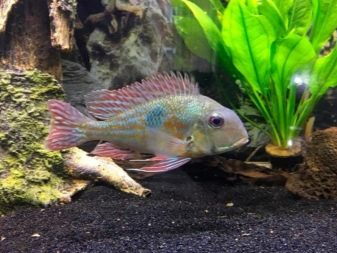
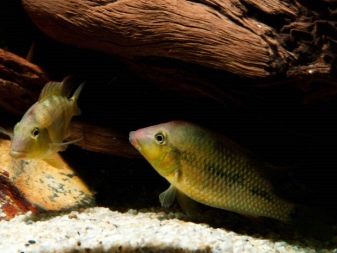
For an overview of geophagus fry in an aquarium, see the next video.








